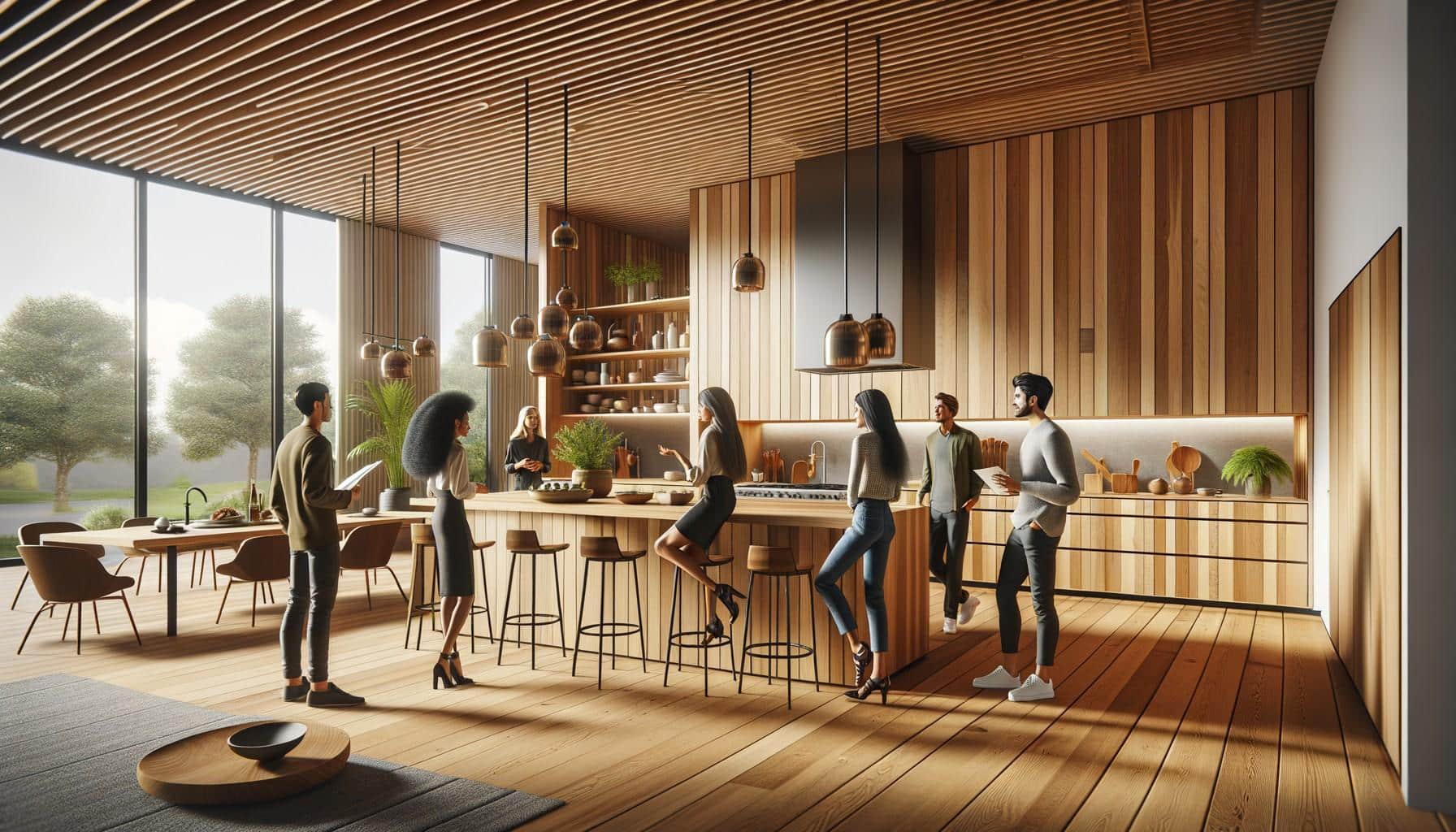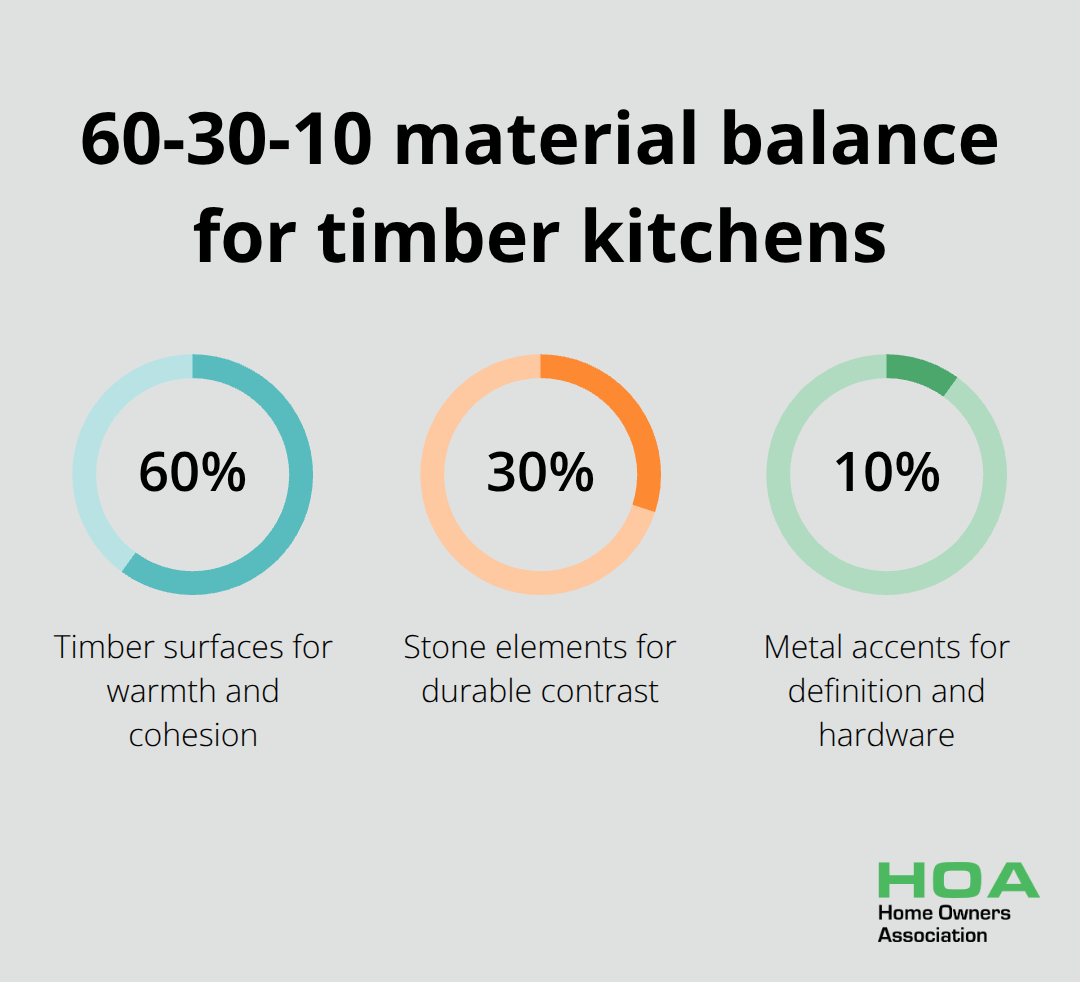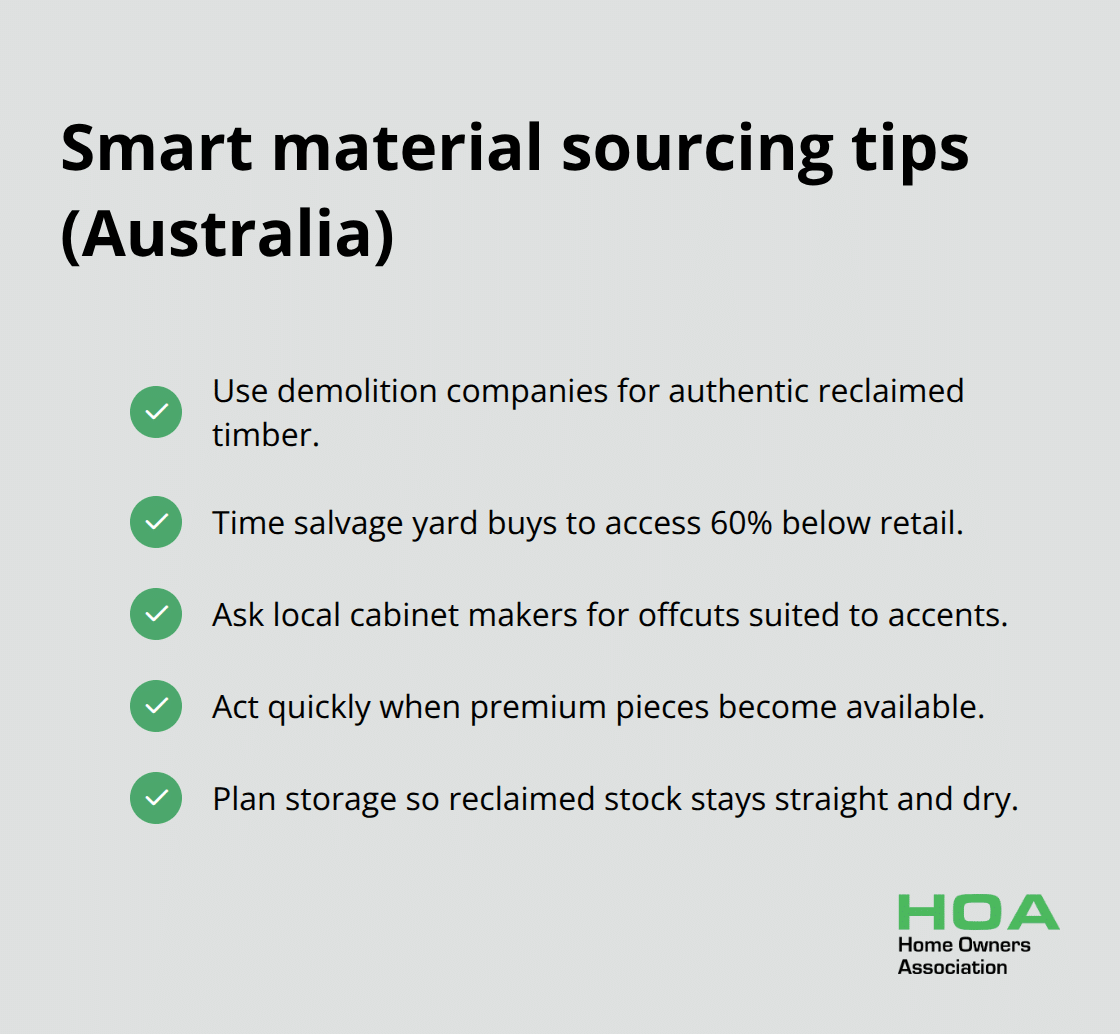
Timber kitchens bring warmth and natural beauty to any home, but outdated designs can make your space feel tired. Smart timber kitchen renovation ideas can transform your cooking area without breaking the bank.
We at Home Owners Association see homeowners achieve stunning results through strategic planning and creative material choices. The right approach combines style with practicality for lasting value.
Which Design Style Works Best for Timber Kitchens
Light Wood Scandinavian Designs Lead the Market
Light wood Scandinavian designs dominate modern timber kitchen renovations, with birch and ash cabinets leading sales. These pale timber options reflect natural light effectively and make smaller kitchens appear 20-30% larger visually. Pair light timber with white subway tiles and brass hardware for maximum impact. The key lies in texture mixing rather than colour variation – combine smooth cabinet fronts with rough-sawn floating shelves and polished concrete benchtops.
Reclaimed Materials Create Character
Reclaimed timber costs 40-60% less than new hardwood while it delivers superior character. Barn wood and salvaged oak beams add instant history to modern spaces. Install reclaimed timber as accent walls behind open shelves or create custom range hoods from weathered planks. The patina and grain variations in reclaimed materials eliminate the sterile look of mass-produced cabinets. Source materials from demolition companies rather than retail stores to achieve authentic aging and significant cost savings (this approach often yields unique pieces with genuine history).
Mixed Materials Maximise Visual Interest
Contemporary timber kitchens succeed through strategic material combinations rather than wood-only approaches. Combine walnut cabinets with Carrara marble benchtops and blackened steel hardware for sophisticated contrast. Natural stone splashbacks paired with timber cabinetry create depth without texture competition.

The 60-30-10 rule applies perfectly – use timber for 60% of surfaces, stone for 30%, and metal accents for the remaining 10%. This proportion prevents visual chaos while it maintains material harmony.
These design foundations set the stage for smart budget strategies that maximise your renovation investment without compromising quality or style.
How Can You Renovate Timber Kitchens on a Budget
Cabinet Refinishing Delivers Professional Results
Refinishing existing timber cabinets costs significantly less than replacement while it achieves identical visual impact. Sand cabinets with 220-grit paper, apply wood conditioner, then use oil-based stain for deeper penetration. Semi-gloss polyurethane finish withstands kitchen moisture and daily wear. The National Kitchen & Bath Association reports that cabinet refinishing projects average $1,600 compared to $8,000 for new installations. Replace hinges and drawer slides during refinishing to eliminate squeaks and improve functionality. Professional-grade equipment rental from hardware stores costs $50 daily but produces showroom-quality results that last 15+ years.
DIY Timber Accents Transform Spaces Affordably
Create accent walls with 1×4 pine boards installed vertically compared to prefabricated panels. For hardwood installations with raised panels, cope and stick joinery, installation, and finishing, expect costs around $125 per square foot. Floating shelves from 2-inch thick reclaimed timber cost $25 per linear foot when you source them from demolition yards versus $80 from retailers. Apply Danish oil finish for natural protection that highlights grain patterns without glossy appearance. Install LED strip lights under floating shelves to showcase timber texture and create ambient kitchen lighting. These projects require basic carpentry skills but generate significant visual impact for minimal investment.
Trade Pricing Reduces Material Costs Dramatically
Purchase timber directly from mills during off-peak seasons when inventory moves slower and prices drop. Hardwood flooring retailers often sell cabinet-grade lumber at reduced rates when they clear warehouse space. Buy timber in bulk quantities then store properly in climate-controlled environments to prevent warping. Australian timber suppliers offer end-of-run pricing on premium species like blackbutt and spotted gum at 50% discounts when quantities exceed 100 board feet (this approach requires proper storage planning but delivers substantial savings).
Smart Material Sourcing Strategies
Source reclaimed materials from demolition companies rather than retail stores to achieve authentic aging and significant cost savings. Salvage yards often stock cabinet-grade timber at 60% below retail prices when you time purchases correctly. Contact local cabinet makers for offcut materials that work perfectly for smaller accent projects. These professionals frequently discard premium timber pieces that suit DIY applications perfectly (though you’ll need to act quickly when opportunities arise).

The foundation of budget-conscious renovation lies in smart material choices, but proper planning and accurate measurements determine whether these savings translate into successful project completion.
What Makes Timber Kitchen Renovation Planning Successful
Accurate Measurements Prevent Costly Installation Problems
Kitchen measurement errors cost homeowners significantly in material waste and rework according to the National Association of Home Builders. Measure each wall three times at different heights since older homes rarely have perfectly square corners. Record measurements to the nearest 1/8 inch rather than round numbers to avoid gaps during installation. Check ceiling heights at multiple points because variations of 2+ inches commonly occur in homes over 20 years old.
Document electrical outlet locations, plumbing connections, and window positions on scaled drawings before you order materials. Professional cabinet makers require these precise measurements to fabricate custom pieces that fit perfectly without field modifications. Use a laser level to identify wall irregularities that standard measuring tapes miss (these tools rent for $25 daily from hardware stores).
Timber Species Selection Determines Long-Term Performance
Choose closed-grain hardwoods like maple or cherry for kitchen environments where moisture resistance matters most. Open-grain woods like oak absorb cooking vapours and require additional sealing steps that increase project costs by 15-20%. Australian spotted gum and blackbutt perform exceptionally well in kitchen applications due to their natural oil content and density ratings above 800 kg/m³.
Avoid softwoods like pine for cabinet construction since they dent easily under normal kitchen use. Quarter-sawn lumber costs 30% more than plain-sawn but delivers superior stability in humid conditions. Test timber samples with water drops to evaluate absorption rates before you make final species decisions.
Professional Installation Eliminates Structural Issues
Complex installations that involve load-bearing modifications require structural engineers and licensed contractors to meet building codes. Attempts at electrical or plumbing relocations without proper certification void home insurance coverage in most Australian states. Licensed tradespeople complete kitchen installations 40% faster than DIY approaches while they maintain warranty coverage on all work performed.

Obtain three detailed quotes that specify timber grades, hardware quality, and completion timelines before you select contractors. Verify trade licences through state regulatory bodies and request recent project references to evaluate workmanship standards. Professional installation typically costs $85-120 per linear foot but eliminates costly mistakes that plague amateur renovations. Kitchen renovations can increase your home’s value by up to 20%, making proper planning essential for maximising your investment return.
Final Thoughts
Timber kitchen renovation ideas deliver exceptional value through natural beauty, durability, and versatility that adapts to changing design trends. These renovations typically cost 30-50% less than complete replacements while they achieve identical visual impact and functionality improvements. Strategic approaches maximise your investment returns through smart material choices and proper execution.
Cabinet refinishing averages $1,600 compared to $8,000 for new installations, while reclaimed materials reduce costs by 40-60% and add authentic character. Mixed-material designs that follow the 60-30-10 rule create sophisticated spaces without overwhelming budgets. Quarter-sawn hardwoods like maple and cherry provide superior moisture resistance that kitchen environments demand (these species outperform softwoods in humid conditions).
We at Home Owners Association connect homeowners with expert renovation guidance that makes quality projects affordable. Our network provides access to trusted contractors and material suppliers throughout the renovation process. Start your timber kitchen transformation by measuring your space accurately, researching local suppliers, and obtaining detailed quotes from licensed professionals.





